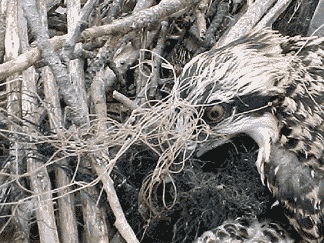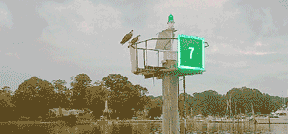Heralding the Ospreys’ Return
Ever faithful, the harbingers of spring are back by St. Patrick’s Day
by Dotty Holcomb Doherty
Osprey are returning to the Bay, carrying the warmth of the equatorial sun on their wings. As eaglets hatch, cardinals sing and tundra swans gather for their Arctic trek, the first male osprey have arrived to repair their nests in anticipation of their mates and summer days on the Chesapeake.
Retracing their fall migration paths, these osprey fly between 2200 and 3000 miles, leaving rainforest fishing holes to breed on the Bay. Each osprey’s clock dictates its departure date; one by one they return. Their journey takes about two weeks, subject to the vagaries of wind and cravings for fish. A benevolent tail wind may propel them over 200 miles in a day; a favorite fishing spot can delay them for hours or a week. From the coast and inland forests of South America they fly, crossing the Caribbean to Hispaniola and Cuba, then on to Florida and up the coast, finally arriving on the Bay from early to mid March. Here, pairs reunite as they do each spring, at the nest they left separately six months before.
Fishermen cheer these harbingers of spring, as the ospreys’ arrival coincides with the return of the fish. The Chesapeake wakes up from winter as first yellow perch, then white perch, river herring, shad and rockfish make their own trek into the shallows of freshwater tributaries to spawn. Historically, fishermen have felt this tie, memorialized by ornithologist Alexander Wilson in his 1831 ode, “The Fisherman’s Hymn.”
The Osprey sails above the sound;
he geese are gone, the gulls are flying;
The herring-shoals swarm rich around;
The nets are launched, the boats are plying.
Yo, ho, my hearts! let’s seek the deep,
Raise high the song, and cheerly wish her,
Still, as the bending net we sweep,
‘God bless the Fish-hawk and the fisher!’
She brings us fish: she brings us spring,
Good times, fair weather, warmth, and plenty;
Fine store of shad, trout, herring, ling,
Sheep’s-head and drum, and old-wives dainty.
Yo, ho, my hearts! let’s seek the deep,
Ply every oar, and cheerly wish her,
Still, as the bending net we sweep,
‘God bless the Fish-hawk and the fisher!’
She rears her young on yonder tree;
She leaves her faithful mate to mind ‘em.
Like us, for fish, she sails to sea,
And plunging, shows us where to find ‘em.
Yo, ho, my hearts! let’s seek the deep,
Ply every oar, and cheerly wish her,
While the slow-bending net we sweep,
‘God bless the Fish-hawk and the fisher!”
Coastal farmers in the 1800s also welcomed the osprey, believing their nests worked like scarecrows. In 1831, John James Audubon wrote: “As these good people affirm, no Hawk will attempt to commit depredations on their poultry, so long as the Fish Hawk remains in the country.”
Audubon explained the scarcity of other hawks by a coincidence of timing: Osprey nest as the other raptors head inland to raise their own young, returning to hunt winter waterfowl when the osprey leave for southern wintering grounds. Farmers nonetheless held to their claims. Wilson explained further: “for such is the respect paid the fish-hawk by the whole neighborhood where it resides, that a person who should attempt to shoot one of them would stand a fair chance of being insulted.”
Back to the Nest
The ospreys’ loyalty to their nests, so admired by the superstitious farmers, has become the bane of the Bay’s Coast Guard. Though tall trees, duck blinds and artificial platforms lure many nesters, over half of Chesapeake ospreys call channel markers home.
For years, the Coast Guard simply removed the nests from navigational markers — as linesmen did from telephone poles — only to have the ospreys return to rebuild. Policy changed, though, in the 1970s when the osprey population dropped dramatically due to DDT. Now, nests are removed only when boating safety is compromised, and only after the young have fledged.
Osprey nests tell stories of their times, as any loose material may wind up woven into the inevitable branches. Whereas Wilson and Audubon spoke of seaweed, mullein, corn stalks and grasses, an 1892 account listed a wide range of items from barrel hoops and staves to sheep skulls, oars, rubber boots and rag dolls. Today, the mélange has turned deadly.
Plastic trash and six-pack rings pose an ongoing threat, but fishing line and the oft-accompanying hooks create a ubiquitous danger on the Bay. A four-year survey by the U.S. Fish and Wildlife Service from 2000 to 2004 found fishing line in 50 percent of nests along Chesapeake tributaries. They also found adults and young maimed or starving to death, enmeshed in the line — a reminder to the over 400,000 Bay anglers to dispose of their line with care.
Unthreatened by small birds, the accommodating ospreys often permit grackles, sparrows and swallows to nest within the lower structures of their nests, but woe to any predator who tries to invade their nest. Ospreys do not defend a territory, as other raptors do, but guard their nests with ferocity. Nineteen-century egg collectors often earned a talon in their head, and birds — from crows to eagles — that try to suck an egg or steal a nestling are attacked, driven away or killed.
President Bill Clinton and a celebratory gathering at Patuxent Naval Air Station witnessed this animosity when, on July 4, 1996, Clinton released a rehabilitated bald eagle, unaware of a nearby osprey nest. The adult ospreys converged on the eagle, driving him far from their young. The eagle, banished into the water, was later rescued by the Coast Guard and re-released in a safer location.
Back from the Verge
Today, as the osprey return, we are witnessing a miracle.
Rising like phoenixes from the cloud of DDT, osprey symbolize hope and the forgiveness of nature. Though we sprayed 1.35 billion pounds of the insecticide in the U.S. for 30 years until its ban in 1972; though it poisoned the food chain causing osprey eggs to thin and break; though osprey populations plummeted nationwide, the Chesapeake birds persevered — and became saviors.
Even at its lowest point in the 1970s, the Chesapeake osprey population still remained the largest in the United States. Ornithologists, seeking to reverse the plunging numbers around the country, erected platforms near rivers and bays to replace nest sites lost to burgeoning coastal development. But too many nests were still failing.
Chesapeake ospreys came to the rescue.
In the 1970s through ‘90s, Maryland Department of Natural Resources supplied osprey nestlings to Pennsylvania, Ohio, Tennessee and New Jersey, where they were reared in hacking boxes, imprinting on the new area and returning to breed after their winter hiatus.
A Massachusetts man’s trip to the Chesapeake in the late ‘60s has become a personal connection for me today.
Gil Fernandez came to the Chesapeake for eggs and chicks to bolster his failing nesters on the Westport River, next to my hometown of South Dartmouth. I never met Mr. Fernandez; I left home just as his work was becoming locally renowned. I read about him on my returns, and about a month ago, read that he had died at age 95. In his memorials, I learned of his trips to the Bay.
“I think he was the first one on the Atlantic Coast to really do more than wring his hands when he realized the osprey were beginning to disappear,” says Kathleen Elizabeth Anderson, chairwoman of the state's Natural Heritage & Endangered Species Program.
With a passion that lasted the rest of their lives, Gil and his wife Josephine began raising nesting platforms and awareness in southeastern New England. Bringing healthy eggs and chicks back from Chesapeake birds and putting them under Westport adults whose nests had failed, Gil helped the population recover. Forty years later, the number of nests has soared on the Westport River from five to 88; the number of nests fledging young from two to 70.
Our ospreys’ gifts of eggs and nestlings had little impact on their own population. Today, the Chesapeake Bay harbors the largest community of osprey in the world, boasting nearly 3600 pairs.
I’ve welcomed the first returning male to my corner of the Bay on South River. His familiar silhouette soars and hovers above the harbor still brimming with tundra swans, buffleheads and scaup; with smatterings of red-breasted mergansers, common golden-eyes and surf scoters. I will linger a bit longer in the kayak these days, enjoying the warmth of the spring sun and watching the osprey: their mid-air shiver as they emerge from the water with a prize fish; their determination as they pump out of the marsh grasses with long pieces of driftwood; their courtship flights filled with sharp keening cries as they reaffirm bonds with their newly arriving mates.
Soon I will return to Massachusetts to visit my family. When I go, I plan to walk the shores of local rivers, carrying greetings to my hometown osprey from their distant cousins on the Chesapeake.
